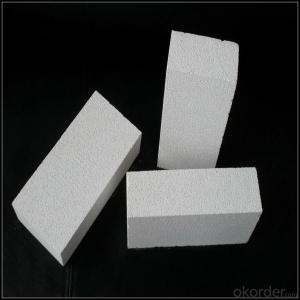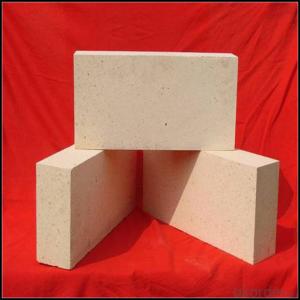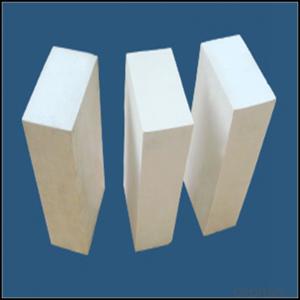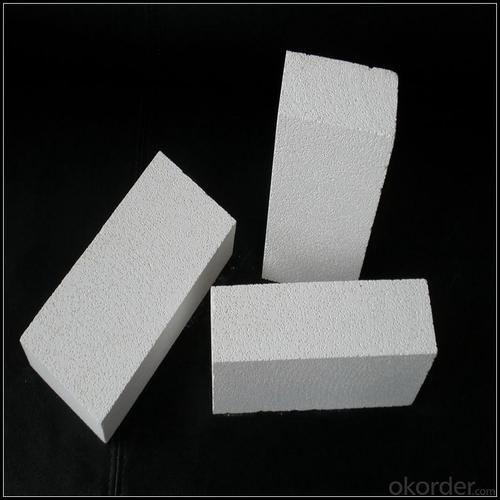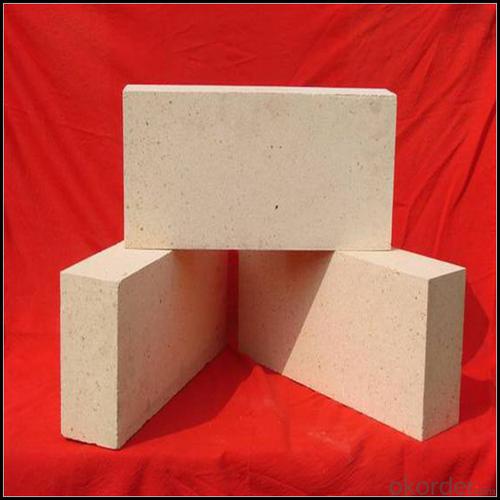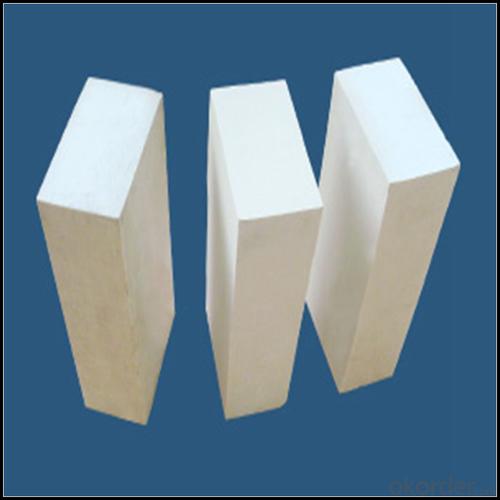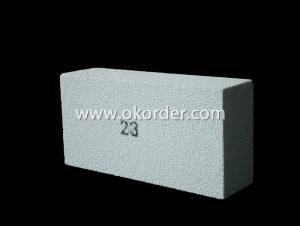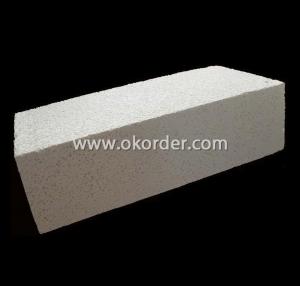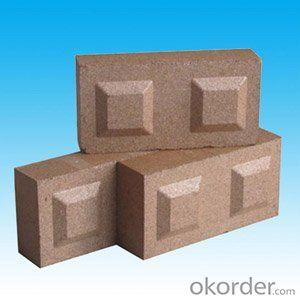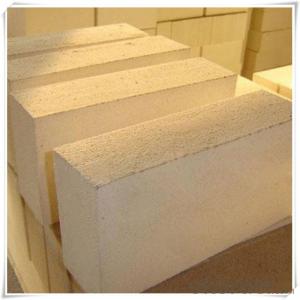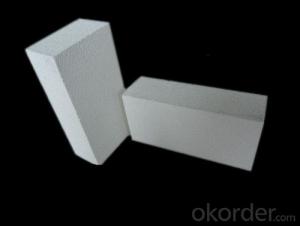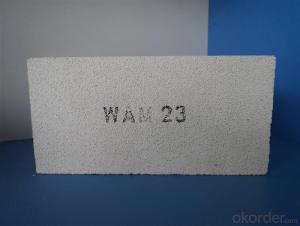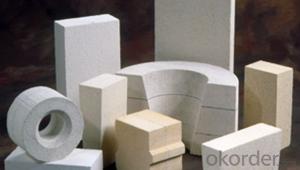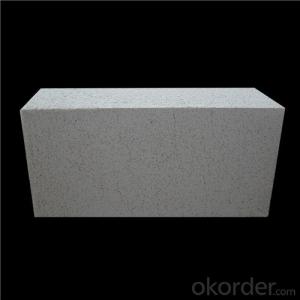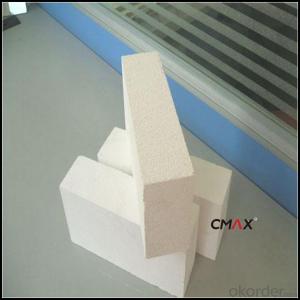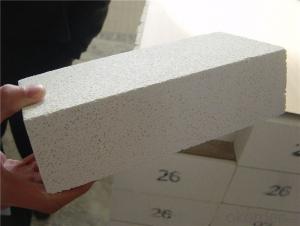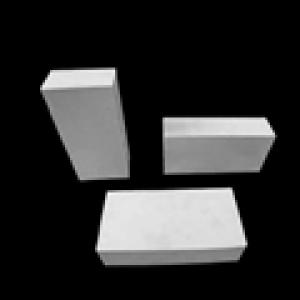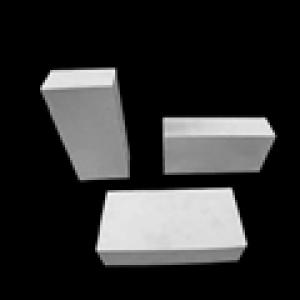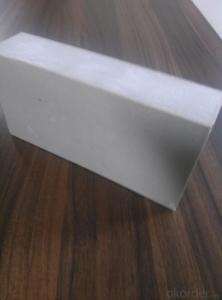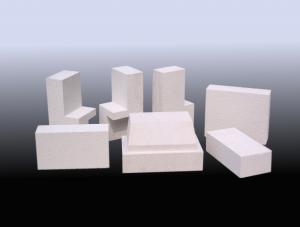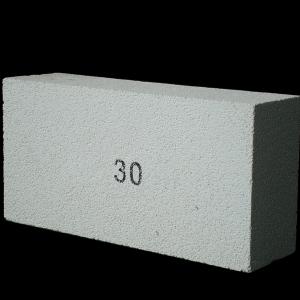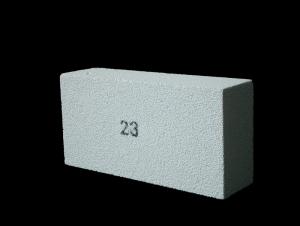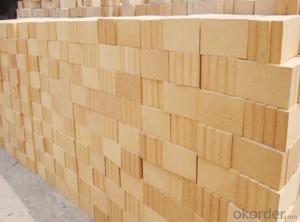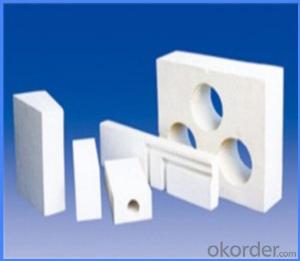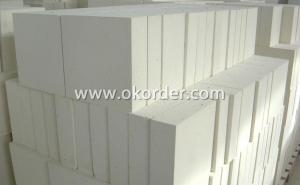Insulating Fire Brick - Acid Resistant Standard Size Bricks
- Loading Port:
- China main port
- Payment Terms:
- TT OR LC
- Min Order Qty:
- 0.1
- Supply Capability:
- 1800 m.t/month
OKorder Service Pledge
OKorder Financial Service
You Might Also Like
Refractory Brick
CMAX firebricks are classified under temperature between 1300℃ to 1700℃, manufactured from high purity alumina clay by mixing, press-forming, drying, sintering and machining. Bricks contain carefully-graded organic fillers which are burned out during sintering to give a uniform controllable pore structure. This technique makes product feature low thermal conductivity and excellent heat insulation
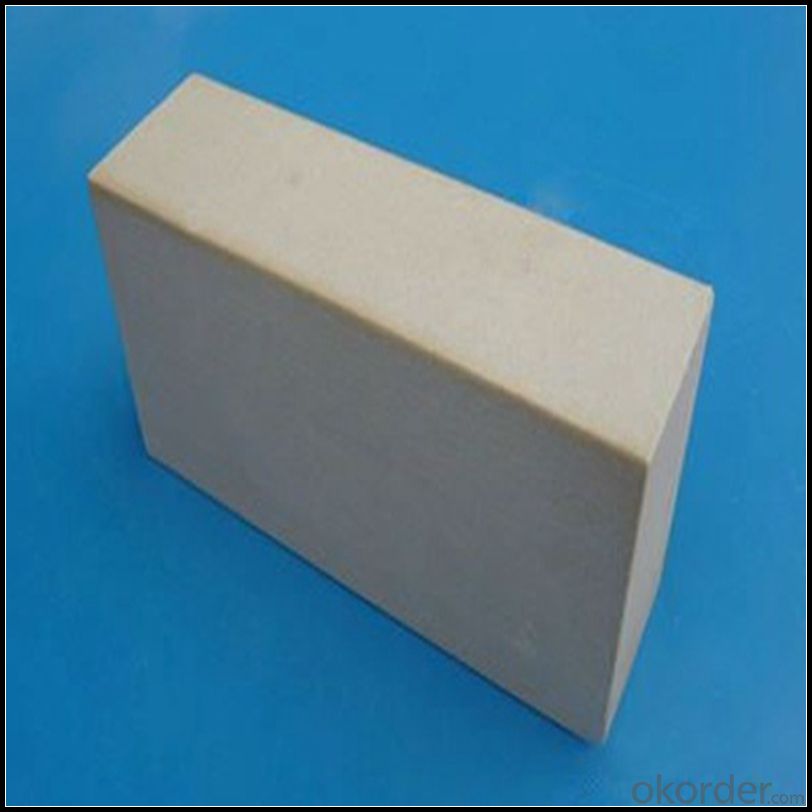
Features
a) Low thermal conductivity;
b) High refractoriness;
c) High mechanical strength;
d) Excellent thermal shock resistance;
e) Non standard sizes and shapes are available upon request.
Application
Light Weight Mullite Insulation Brick can be widely used for lining or insulation layers of various industrial furnaces and kilns in metallurgical industry, machine building industry, ceramic industry, chemical industry.
Data Sheet
Classification Temperature (℉/℃) | 3000/1650 |
Bulk Density (g/cm3 ) | ≤1.0 |
Thermal Conductivity | |
800℃, W/m.K | ≤0.39 |
1000℃, W/m.K | ≤0.43 |
1200℃, W/m.K | ≤0.48 |
Reheating Linear Change (%) | 1550℃×12h |
≤0.9 | |
Chemical Composition (%) | |
Al2O3 | ≥75 |
Fe2O3 | ≤0.5 |
Packaging & Shipping
Packaging Details:Be packed in fumigated wooden pallets
Delivery Detail: 30 days after order

Our Services
Optimum solution and product supply of refractories for high temperature industries, such as iron steel, non-ferrous, petrochemical and building materials.
Engineering design, contract and consult for refractories, and civil architecture design.
Research, development, manufacture and sale of superhard materials.
R&D, manufacture and sale of special packing materials for export.
Inspection, supervision and arbitration of refractories.
Consultation and services in refractories information.
Training and cultivation of high-level talents in refractories profession
Sales Network

Company Information
CNBM (China National Building Material) Group is the largest comprehensive building materials group in China that in integrate scientific research, manufacturing and logistics into one entity. The largest building materials and equipment specialists in China. Upon State Council approval, today CNBM owned more than 300 subordinate manufacturing factories and servicing companies. There are 6 fully owned public listed companies and 11 partially owned with substantial shares public listed companies. In many of these fields, CNBM is playing the leading role in the building industry in the country.
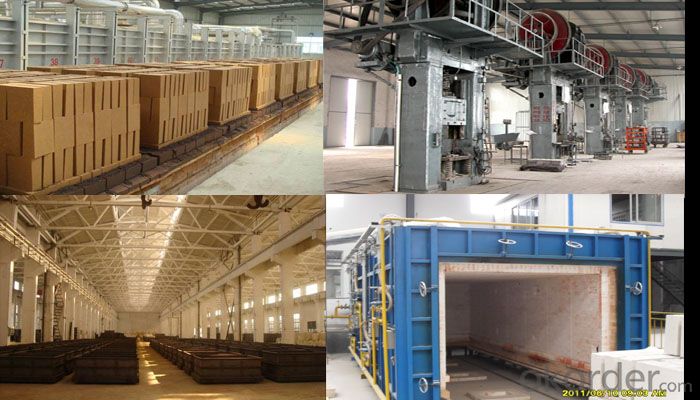
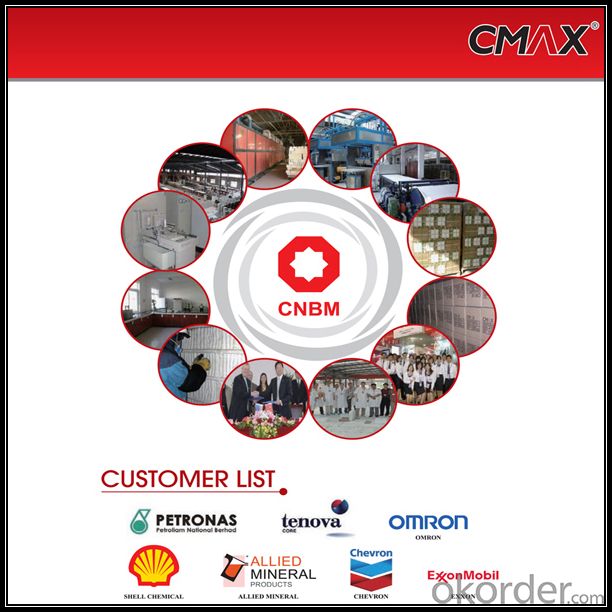
FAQ
1. Which products do you have?
We have all kinds of refractory brick, castable, mortar, cement, ceramic fiber products, etc.
Or you could browse our products to choose what you need.
2. Can you give me a brief introduction of the application of your products?
We are mainly specializing in the refractory materials in iron and steel, cement, glass, ceramics, petrochemical, electric power Industry, etc.
3. If I need your offer, what information do you need?
In order to choose suitable products, it will be appreciated to provide us the information, such us specification, technical data, order quantity, products application etc. If any question, please contact us freely.
- Q: Can insulating fire bricks be used as a lining for chimneys?
- Yes, insulating fire bricks can be used as a lining for chimneys. These bricks are designed to withstand high temperatures and provide insulation, making them suitable for lining chimneys and protecting them from heat damage.
- Q: Can insulating fire bricks be used in the construction of pottery molds?
- Yes, insulating fire bricks can be used in the construction of pottery molds. Insulating fire bricks are made from lightweight refractory materials that have excellent heat insulation properties. These bricks are specifically designed for applications that require high temperatures, such as pottery kilns. When constructing pottery molds, it is important to have materials that can withstand the intense heat of the kiln. Insulating fire bricks can withstand temperatures up to 3000°F (1650°C), making them suitable for pottery mold construction. They provide insulation to prevent heat loss and maintain consistent temperatures inside the kiln, which is essential for achieving the desired firing results. Furthermore, insulating fire bricks can be easily shaped and cut to fit the desired mold design. They are also lightweight, which makes them easier to handle during the mold construction process. Additionally, the insulating properties of these bricks help to reduce energy consumption by preventing excessive heat loss, making them cost-effective in the long run. Overall, insulating fire bricks are a suitable choice for constructing pottery molds due to their ability to withstand high temperatures, provide insulation, and be easily shaped to fit specific designs.
- Q: How do insulating fire bricks affect the overall carbon footprint of a structure?
- Insulating fire bricks can significantly reduce the carbon footprint of a structure. These bricks have higher thermal insulation properties compared to traditional bricks, which means they can better retain heat and reduce the need for excessive heating or cooling. By improving energy efficiency and reducing the consumption of fossil fuels, insulating fire bricks help to lower the carbon emissions associated with the structure's operation. Additionally, their longer lifespan and recyclability contribute to further environmental benefits by reducing waste generation and the need for frequent replacements, ultimately minimizing the overall carbon footprint of the structure.
- Q: Can insulating fire bricks be used in contact with molten metals?
- Yes, insulating fire bricks can be used in contact with molten metals. Insulating fire bricks are designed to handle high temperatures and can withstand the heat generated by molten metals. They have excellent insulation properties and can effectively protect against heat transfer, making them suitable for various applications involving molten metals.
- Q: Are insulating fire bricks resistant to hydrogen sulfide?
- Yes, insulating fire bricks are generally resistant to hydrogen sulfide due to their high melting point and chemical stability.
- Q: Are insulating fire bricks resistant to phosphorus pentoxide?
- Insulating fire bricks are generally not resistant to phosphorus pentoxide. Phosphorus pentoxide is a highly reactive compound that can corrode and degrade most materials, including insulating fire bricks. It is important to consider alternative materials or protective coatings if there is a need for resistance to phosphorus pentoxide in a specific application.
- Q: Are insulating fire bricks suitable for insulation in cryogenic applications?
- Yes, insulating fire bricks are suitable for insulation in cryogenic applications. Insulating fire bricks are made from lightweight refractory materials that have excellent thermal insulation properties. They have low thermal conductivity, high melting points, and are able to withstand extremely low temperatures, making them ideal for cryogenic applications. Cryogenic applications involve handling and storing materials at very low temperatures, typically below -150 degrees Celsius (-238 degrees Fahrenheit). Insulating fire bricks are designed to provide effective insulation in such extreme temperatures, preventing heat transfer and maintaining the desired low temperature. Furthermore, insulating fire bricks are chemically stable and have good resistance to thermal shock, meaning they can withstand rapid temperature changes without cracking or deteriorating. This is particularly important in cryogenic applications where temperature fluctuations are common. In addition to their excellent thermal insulation properties, insulating fire bricks are also lightweight and easy to handle, making them convenient for installation in cryogenic systems. Overall, insulating fire bricks are a suitable choice for insulation in cryogenic applications due to their thermal insulation properties, high-temperature resistance, chemical stability, and resistance to thermal shock.
- Q: Can insulating fire bricks be cut or shaped to fit different spaces?
- Yes, insulating fire bricks can be cut or shaped to fit different spaces. Insulating fire bricks are made from lightweight materials that can be easily cut or shaped using common tools such as saws, knives, or rasps. This allows for customization and precise fitting in various spaces, including fireplaces, kilns, furnaces, and other high-temperature applications. It is important to remember, however, that proper safety precautions should be taken when cutting or shaping insulating fire bricks, as they may produce dust or debris.
- Q: Can insulating fire bricks be used in ceramic kilns?
- Yes, insulating fire bricks can be used in ceramic kilns. Insulating fire bricks are designed to have low thermal conductivity, which means they are able to retain heat more effectively. This makes them an ideal choice for lining the walls of a kiln, as they help to conserve and distribute heat more evenly throughout the kiln chamber. Additionally, insulating fire bricks are lightweight and have a high resistance to thermal shock, which makes them durable and able to withstand the high temperatures typically reached in ceramic kilns.
- Q: Can insulating fire bricks be used in the construction of incinerators?
- Indeed, insulating fire bricks are applicable for utilization in the construction of incinerators. The paramount significance lies in the exceptional thermal insulation properties possessed by these bricks, which play a vital role in sustaining elevated temperatures and enhancing energy efficiency within the incinerator. The bricks' low thermal conductivity enables them to proficiently retain heat and curtail heat loss. Moreover, their resistance to high temperatures enables them to endure the intense heat generated by the incineration process. Consequently, these bricks emerge as an appropriate preference for lining the walls, floors, and roofs of incinerator chambers, thereby ensuring the incinerator's efficient and secure operation.
Send your message to us
Insulating Fire Brick - Acid Resistant Standard Size Bricks
- Loading Port:
- China main port
- Payment Terms:
- TT OR LC
- Min Order Qty:
- 0.1
- Supply Capability:
- 1800 m.t/month
OKorder Service Pledge
OKorder Financial Service
Similar products
Hot products
Hot Searches
Related keywords
